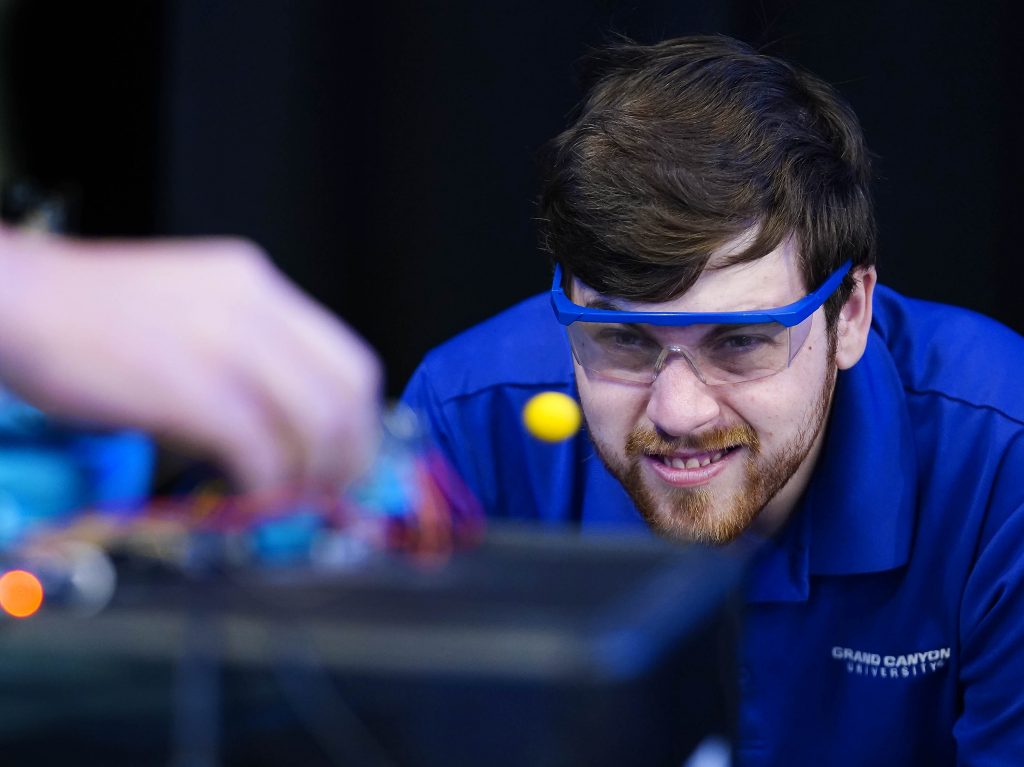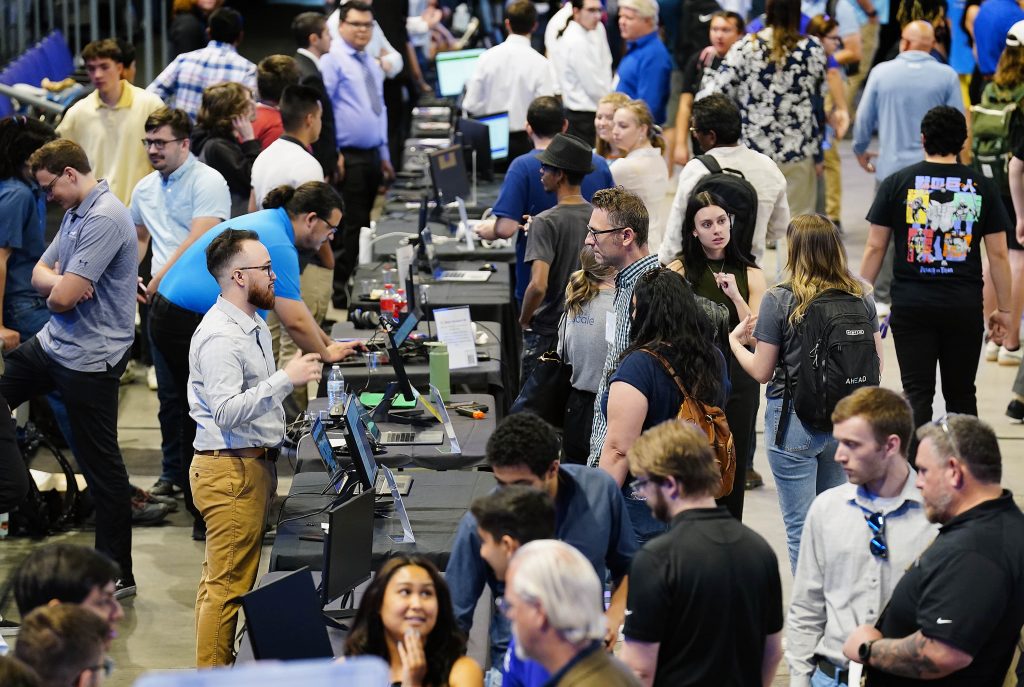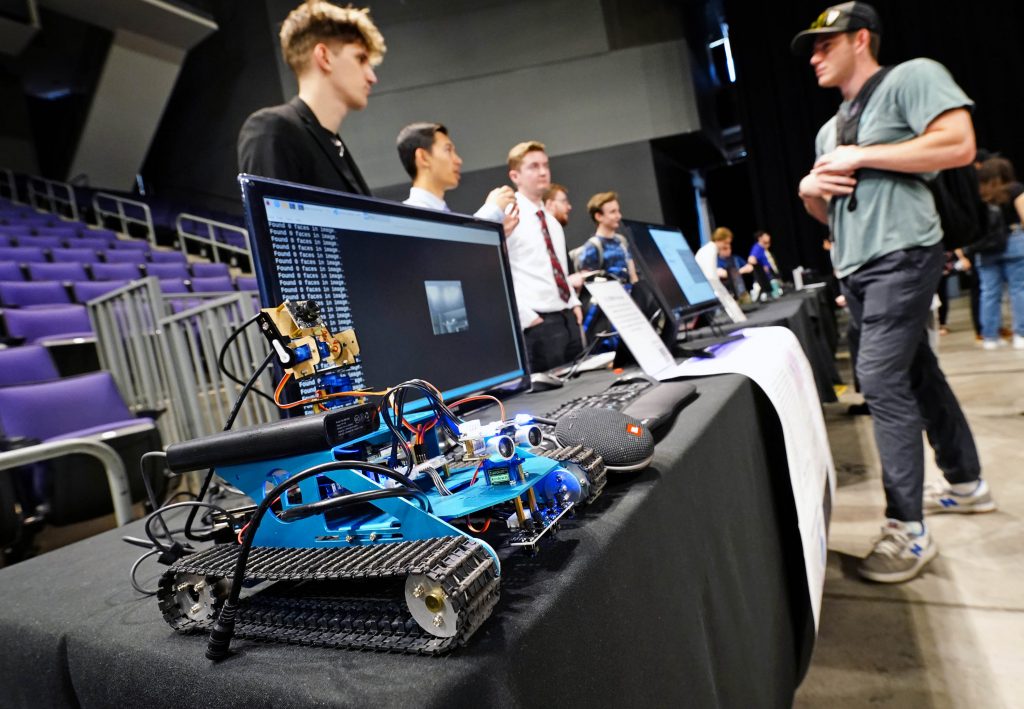
Photos by Ralph Freso / Slideshow
To be pelted in the face a hundred times? For Adam Abrams-Flohr, no problem. The Grand Canyon University senior placed his face in front of the pelting device, sacrificing what he could in the name of computer science.
He put himself in the line of fire of his and project partner Nick Kohout’s Facial Recognition Firing System, a mini launcher that gears up to hurl a foam ball when it detects a face in the firing zone.
The project combines facial recognition technology with a missile-control and firing system to showcase how artificial intelligence can interface with robotics — a perfect fit for Abrams-Flohr, who will start a job at Raytheon Missiles & Defense after graduation.
Not only is it a great stress reliever, “It’s fantastic for managing your posture,” he said of making sure you’re standing just-so to get the system to boot up.
It was among approximately 70 software development, software engineering, cybersecurity and computer science projects on display Thursday at GCU Arena for the Spring Technology Showcase.

The College of Science, Engineering and Technology event, organized in partnership with Career Services, is designed so the campus community, board members and potential employers from industry can see just what the University’s technology students can do. For the past year, the graduating seniors have been preparing for the showcase in their yearlong capstone course, spending a semester designing their projects and another building them.
“I am impressed with the number of creative, unique projects that are solving real-world problems,” said Associate Dean of Technology Dr. Pam Rowland. “… The engagement was amazing to be a part of.”
Abrams-Flohr was more than ready to share the spotlight with the COBOL to Java team a few tables down from him. Its project, he said, is pretty cool.
Austin Chandler, Hunter Egeland, Evan Lee and Lauren Roe created software that takes COBOL 85, an old code developed in the late 1950s, and updates it to Java, a newer code, by using machine learning.
It was something they took on for the company Paychex.

“This has been a pretty long project,” said Chandler of COBOL to Java, which the team started even before its capstone course. “We’ve been on it for 18 months now.”
Lee said, “One of the really cool things about the translations is that with the architecture we have set up, now we’re able to translate COBOL into any other programming language.”
So while Paychex wanted to convert to Java, the team’s software can go from COBOL to Assembly or Python, for example.
“That was something that was very important to us,” said Lee. “COBOL is something companies don’t want to invest in anymore. … so being able to write something that can also be future-looking, so it can do translations in the future, is kind of what we’re touching on.”
The Artsy team also focused on programming language for its capstone.
“Artsy is a brand new programming language out for the world to see,” said an excited Andrew Esch, who developed the language with Albert Gonzales, Karan Sharma and Asher Shores.“… We saw a huge need in middle schools. There’s no programming classes. There’s no way for students to be able to learn on their own, and middle school time is the more opportune time for a kid to be able to learn programming logic, not in high school, not in college.”
Added Gonzales, “When I started with Java, I freaked out a little bit, ‘This is a lot!’ But this is such an easy thing to learn and grasp and prepare for the harder languages.”

Software development seniors Jesseña Quiñones and Zachary Almas chose to go the health route for their projects.
Quiñones created a mental health awareness app called LopesTalk. It allows GCU students to take care of their virtual pet, Lopey, by completing self-care tasks.
“I used to have this app called Finch. It’s a little virtual friend you hatch and grow up from a little egg. It was really fun. I thought, I’m going to try doing that for GCU students,” Quiñones said.
After logging in, students complete daily tasks. Under the “Emotional” tab, for example, they can choose from “meditate for 30 minutes” to “practice journaling.”
In doing her project, Quiñones said she learned so much, such as using software development kit Flutter for the first time. For capstone, students are thrown into projects in which they tackle everything, as opposed to the work world, where you usually concentrate on just one aspect of a project.
“I got all that experience, so it’s nice to put on my resume.”
Zachary Almas’ Cared4 app is something he came up with after he got sick and Googled his symptoms.
“It basically told me I was dying,” he said. “But I’m still here, so I don’t think that was very accurate.”
He wanted to make a user-friendly, self-diagnosing app that offers the most realistic diagnoses “rather than scaring users by proposing rare conditions.”

Matt Reeb and his Homeshield team of Avery Benis, Ayden Stigall, Emmit Castillo and Gatlin Mealer were proud to show off their all-inclusive home security system, which not only tracks a home’s network security but also includes surveillance of carbon dioxide levels, smoke, fire, gas and more.
The network feature, “That’s what kind of separates us from other home security companies. We focus more on that networking side … so anyone can manage their network and make themselves less prone to being attacked,” Reeb said.
Though being attacked is something Ryan Scott embraced for the characters in his and teammates Justin Dietrich, Zach Pedersen and Diego Guerra’s computer game, “Mr. Nugs.”
In the game, a man-turned-chicken-nugget vows revenge on those who have wronged him.
“It’s a turn-based, chicken nugget murder fest pretty much,” said Scott. The chicken nuggets in the game engage in a friendly battle and, by the end, the battle field is littered with chicken nuggets that have met their doom via mesh slicing, as in the game Fruit Ninja.
What Pedersen loved about the project was the creative freedom the team had.
Added Scott, “It was definitely a passion project I’ve had for a while. I was glad to be able to get these guys in on it.”
Paul Cozza of Tech One, a member of the Technology Advisory Board, was at the showcase to view the projects on the packed Arena floor. His company runs a Technology Apprenticeship Program and has placed GCU apprentices at companies it partners with, such as Discount Tire and Republic Services.
The program focuses on getting students practical experience and on-the-job training. Cozza saw all the hands-on training students were engaged in at the showcase and loved it.
“They’re fun,” he said.
With face-pelting via mini launchers and chicken-nugget revenge, he might just be right.
Manager of Internal Communications Lana Sweeten-Shults can be reached at [email protected] or at 602-639-7901.
GCU News: Students' high-tech projects impress industry
GCU News: All the technology buzzwordds? They're here
GCU News: AR, VR changing our reality















